
Hiking Around Las Vegas, Mojave National Preserve

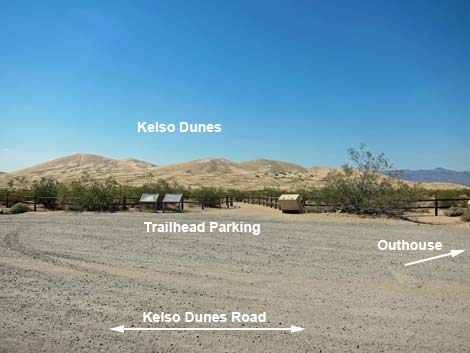 Kelso Dunes trailhead parking (view NW) |
Overview Kelso Dunes is an expansive area of shifting sands partially stabilized by a small variety of hardy shrubs that, in turn, provides habitat for a surprising variety of bugs, lizards, snakes, and mammals. The sand dunes spread across 45 square miles and rise to a height of about 650 feet above lands to the north, but visitors can experience that wild grandeur of the area with a short walk down the trail. The trail starts between fencing intended to protect trailhead vegetation, but after the first few minutes, visitors leave the fencing behind and the trail fades into the sand. Early on, there is a fairly well defined use-trail, but even that eventually fades into the drifting sands. The summit is always in view, and turning around, the trailhead usually is in view, so there is little chance of getting lost. Link to map. |
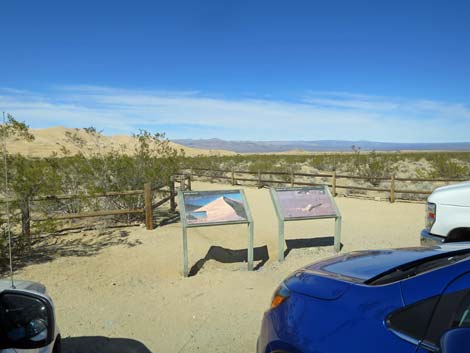 Trailhead information signs (view N) |
Watch Out Other than the standard warnings about hiking in the desert, ...this is a safe area. Guard your eyes and camera equipment when the wind blows sand. While hiking, please respect the land and the other people out there, and try to Leave No Trace of your passage. Also, even though this is a short hike, be sure to bring what you need of the 10 Essentials. This area is in the Mojave Wilderness Area, so pay particular attention to respecting the land. |
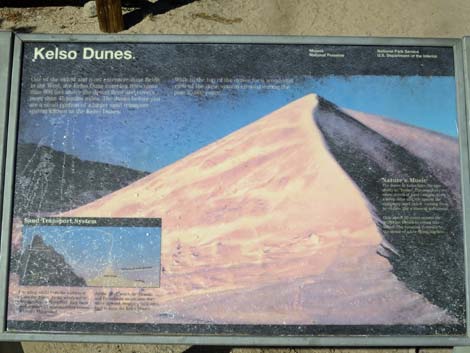 Information about the origin and nature of sand dunes |
Getting to Kelso Dunes Kelso Dunes is located in Mojave National Preserve, about 2 hours south of Las Vegas. From town, drive out to the Kelso Depot Visitor Center. In Kelso, turn left and drive south on Kelbaker Rd. Cross the railroad tracks and continue south for 7.8 miles (towards Interstate-40) to Kelso Dunes Road, which is just before some tin buildings on the right that can be seen from miles away. Turn right onto Kelso Dunes Road and drive west for 2.9 miles to a pullout with vault toilets, which are near the highest dunes. Park here; this is the trailhead. |
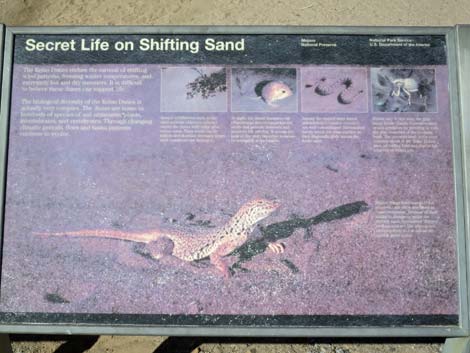 Information about the creatures that live on the sand |
The Hike From the trailhead (Table 1, Waypoint 01), fencing guides hikers onto the trail, and beyond the fencing, the use-trail leads north towards the highest sand dunes. After 200 yards or so, there is no particular route, but many routes wander out into the sand. Try to avoid walking on the vegetation because it is hard enough for plants to live out here without getting trampled. The east ridge of the highest dune makes for a reasonable route to the summit. The route into the dunes starts out heading slightly downhill following the slope of the land. Through this area, the vegetation is typical of lower-elevation Mojave Desert: vast flats of Creosote Bush and White Bursage on coarse, sandy soils. After about 0.2 miles, the "trail" gets to the edge of the dune field (Wpt. 02), and the vegetation switches to species that can survive on the shifting sands: here bunchgrasses (Big Galleta Grass) and shrubs such as California Croton, Thurber's Sandpaper Plant, and Desert Twinbugs (Dicoria canescens) thrive. |
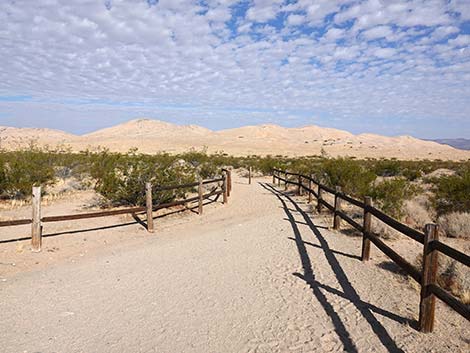 Fencing guides hikers onto the trail (view NW) |
Out in the dunes, watch for footprints of animals that live on the sand. The 4-inch diameter burrows around the bushes are mostly dug by Desert Kangaroo Rats. These cute little rodents hop on their hind legs like kangaroos. They have long tails with a tuft of fur on the end that they use for balance. Watch for their tracks. When they are hopping along slowly, you will see pairs of side-by-side footprints with a mark where their tail drags in the sand. If hopping fast, they hold their tail in the air for balance, so there is no drag mark, and the paired footprints can be several feet apart. Black-tailed Jackrabbits also live on the sand. Watch for their tracks and scat around plants Lizards also make tail-drag marks, but their footprints are alternate rather than paired. Watch for the tracks of "sand swimmers" (Mojave Fringe-toed Lizards): lizard tracks that disappear into the sand when the lizards go underground. |
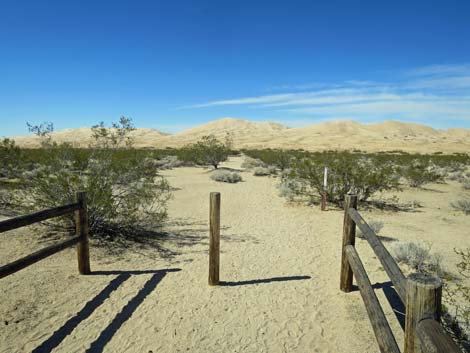 End of the fencing (view NW) |
Bird prints can be paired, but they tend to alternate and never have a drag mark. Most birds have three toes pointed forward and one toe pointed backwards, but Greater Roadrunners have an X-shaped footprint. Snake tracks are seldom seen, but watch for lines of smoothed out sand with no footprints. If you are really lucky, you might find the disconnected, S-shaped tracks of a Sidewinder. If you follow the tracks and find the snake, don't try to pick it up. Most people who are bitten by rattlesnakes get that way because they tried to catch the snake, and the poor little frightened thing is just trying to defend itself from the monster. |
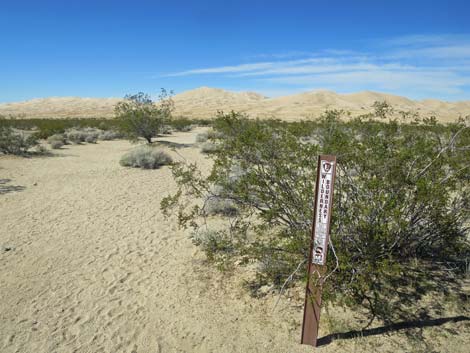 Wilderness Area boundary marker along the trail (view NW) |
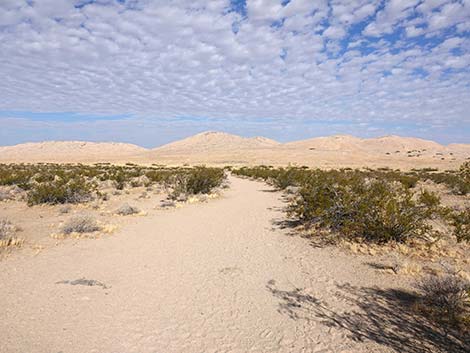 A broad, sandy trail descends through creosote flats (view NW) |
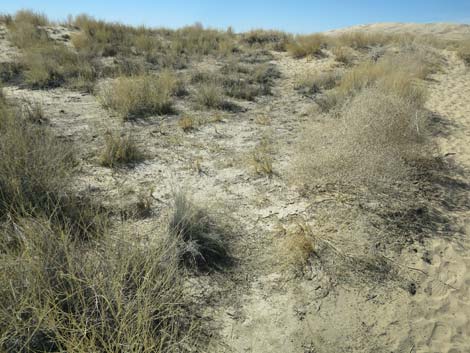 At the low point, mud collects during rain storms |
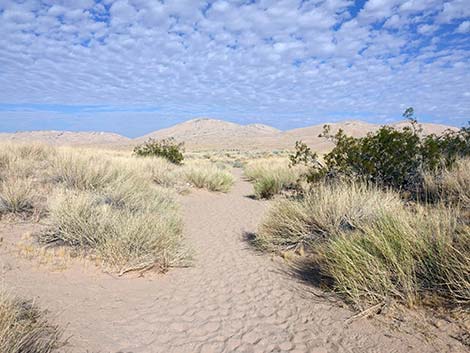 Past the low point, the trail climbs gradually |
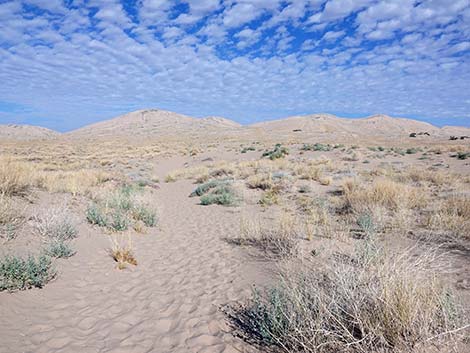 Open, sandy area with grasses and shrubs (view NW) |
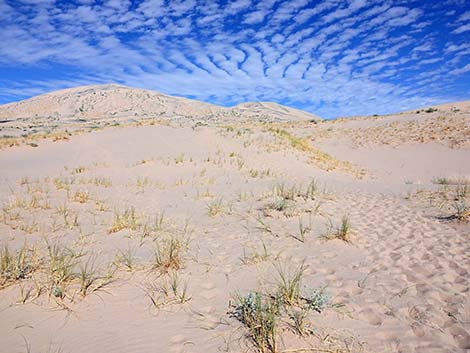 Visitors can wander where they want in the loose sand (view NW) |
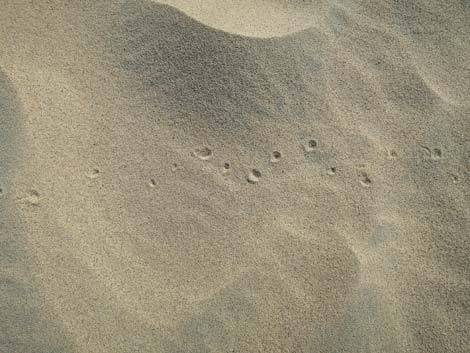 Curious tracks (probably fringe-toed lizard) |
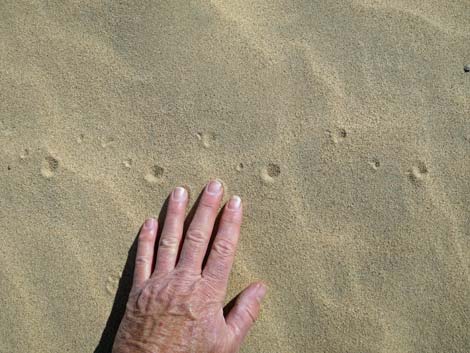 Curious tracks (probably fringe-toed lizard) |
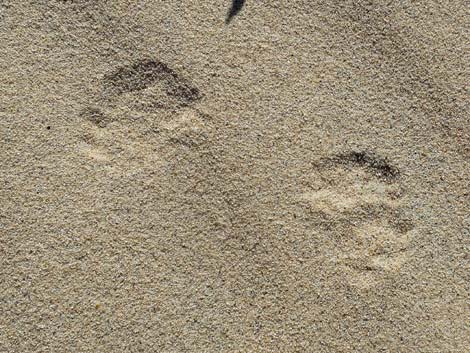 Jackrabbit tracks |
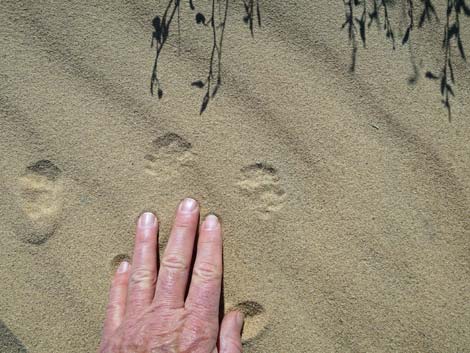 Jackrabbit tracks |
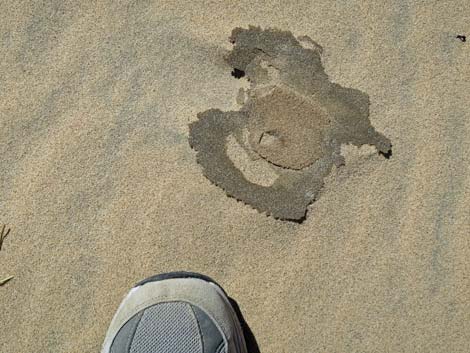 Jackrabbit urine spots used multiple times |
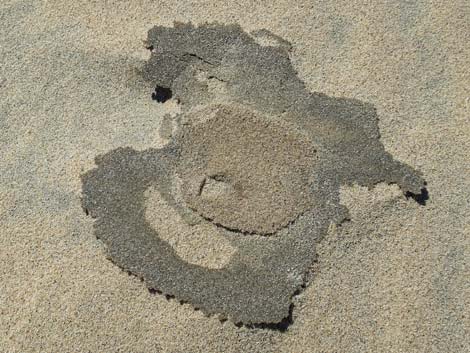 Jackrabbit urine spots used multiple times |
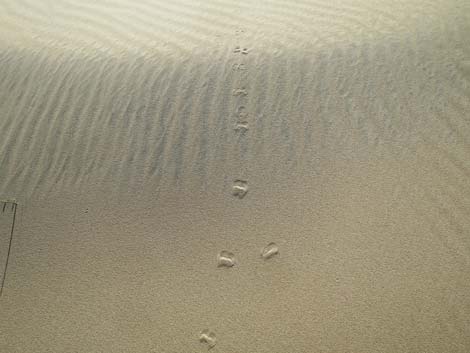 Paired kangaroo rat tracks climbing sand dune |
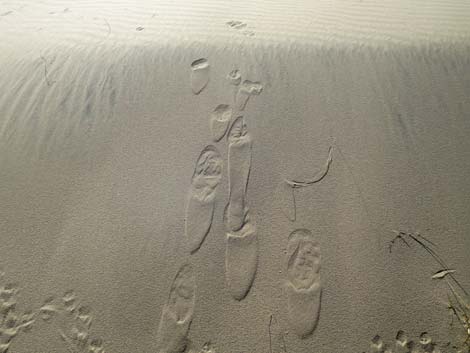 Paired kangaroo rat tracks climbing sand dune |
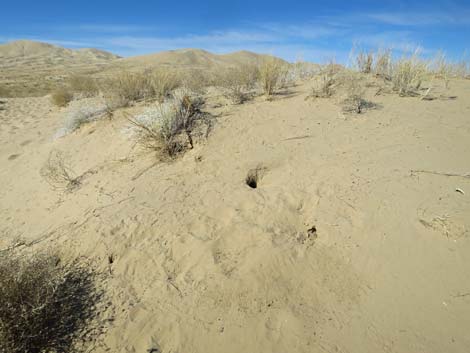 Desert Kangaroo Rat burrow |
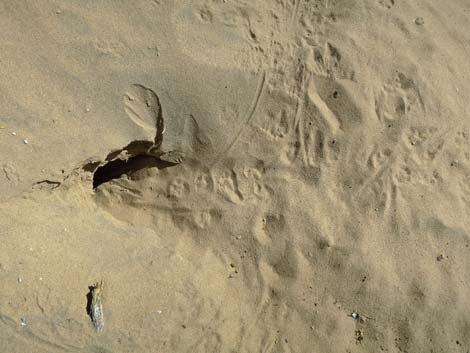 Desert Kangaroo Rat burrow |
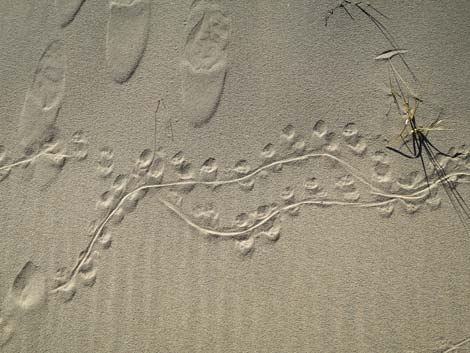 Lizard tracks |
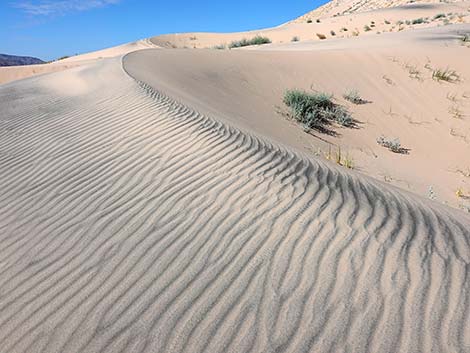 High winds produce ripple marks in the sand |
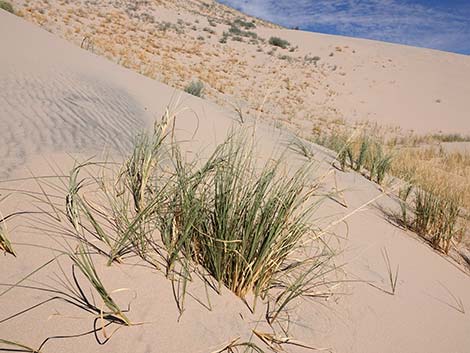 Bunchgrasses (Big Galleta Grass) grow on the dunes |
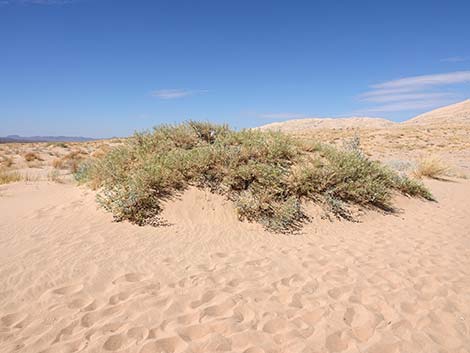 Thurber's Sandpaper Plant on the dunes |
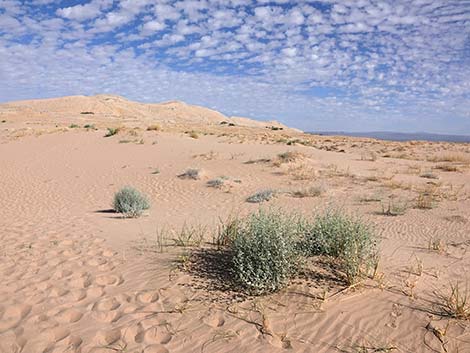 Desert Twinbugs (Dicoria canescens) seems too green to live here |
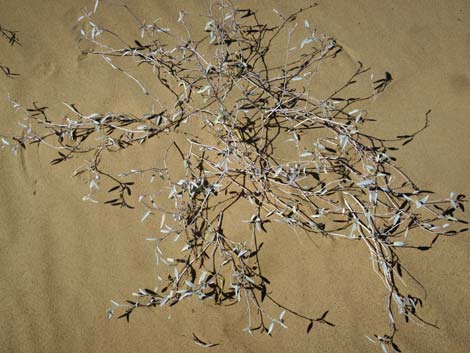 California Croton is common on the sand |
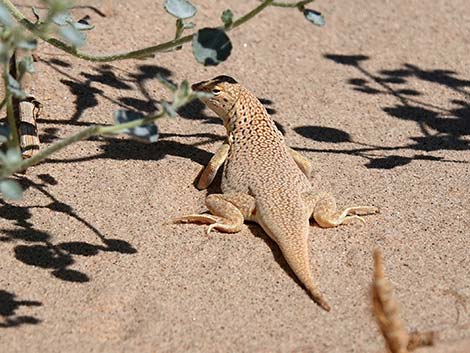 Mojave Fringe-toed Lizard |
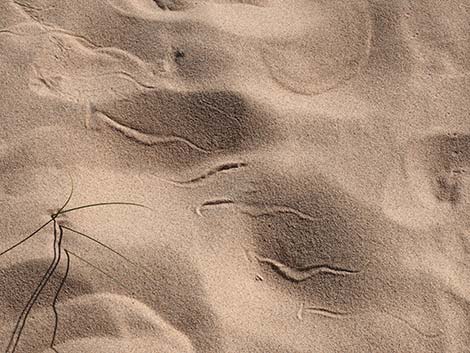 Tracks from a young Sidewinder in the sand |
Table 1. Hiking Coordinates Based on GPS Data (NAD27; UTM Zone 11S). Download Hiking GPS Waypoints (*.gpx) file.
| Wpt. | Location | UTM Easting | UTM Northing | Elevation (ft) | Point-to-Point Distance (mi) | Cumulative Distance (mi) |
|---|---|---|---|---|---|---|
| 01 | Kelso Dunes Trailhead | 618949 | 3861683 | 2,605 | 0.00 | 0.00 |
Happy Hiking! All distances, elevations, and other facts are approximate.
![]() ; Last updated 241019
; Last updated 241019
| Hiking Around Mojave Preserve | Hiking Around Las Vegas | Glossary | Copyright, Conditions, Disclaimer | Home |